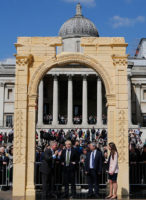Soon after Baltimore’s Henderson-Hopkins School opened its doors to hundreds of students, the day after New Year’s 2014, it was greeted with resounding critical acclaim across the design community.
The new K–8 public school, with its modern, rust-colored forms, spacious teaching areas, and light-flooded common spaces, was regarded as exemplifying the forefront of 21st-century school design—a model to be replicated. What’s more, the school, operated by Johns Hopkins University in partnership with Morgan State University, and backed by the nonprofit East Baltimore Development Inc., was meant to be a boon for East Baltimore, the crown jewel of a new mixed-income development in one of the city’s most disenfranchised neighborhoods.
For its innovative design and progressive educational and social agenda, Henderson-Hopkins, a competition-winning design by New York firm Rogers Partners, received numerous accolades, including an AIA Honor Award and Education Facility Design Award last year. As the jury put it, the school was “Aldo van Eyck meets Alejandro Aravena in Baltimore.”
But according to a recent investigation by The Baltimore Sun, the school hasn’t been living up to its initial promise. Test scores have faltered; suspension rates have mounted. To some parents, the situation is so dire, they are considering pulling their children out, according to the newspaper.
The Sun article named several factors that have contributed to these issues, chief among them, the failure to achieve the school’s goal of creating a racially and socioeconomically diverse student body, a condition research has shown contributes to successful learning. The creation of new housing for the surrounding $1.8 billion mixed-income development—intended to attract young, middle-class families (742 families were moved to make way for it)— has had a slow start.
But the article also pointed to another cause: the much-venerated building design.
The school, divided into five distinct “houses” to accommodate different grades, included a mixture of traditional classrooms, shared teacher spaces, flexible learning spaces, and several dining spaces. But such a design, according to the Sun, “hasn’t worked well”: teachers have found the large spaces difficult to teach in; wide hallways and open spaces have proved distracting for students; multiple cafeterias are difficult to supervise.
Andrew Frank, special advisor to the president on economic development at Johns Hopkins, told record in an e-mail, “Visitors today still marvel at the boldness of the design and light-filled corridors. But those of us who work or spend time in the building can only laugh at the poetry used by architect[s], juries, or journalist[s] to describe the building.” The school will begin to implement a series of design alterations over the summer, including the installation of new walls to divide some of the open spaces.
Rogers Partners’ principal Robert Rogers suspects there has been a pedagogical disconnect in the way the school was designed and how it is currently being operated—a change spurred by leadership changes at the Johns Hopkins School of Education, the institution that oversees the school’s day-to-day operations. The architects had worked closely with East Baltimore Development Inc., the nonprofit behind the development, and David Andrews, dean of the School of Education, who has since left. “The school was designed for specific ways of thinking and learning,” Rogers says.
The architects also designed the school to anticipate change, integrating mechanical, electrical, and lighting systems that would allow spaces to be adapted as needed. They were also careful to engage stakeholders in the planning process by soliciting feedback and holding community meetings. But, says Rogers, “The nature of the school has made it a target for controversy from its day of origin.”
Though a radical $53 million building like Henderson-Hopkins can provide a visible—and convenient—scapegoat, myriad factors contribute to school performance, says David Wilson of Learning Environments for Tomorrow, an institute run jointly by Harvard’s schools of education and design. “In and of itself, the space isn’t going to drive pedagogy—it’s the people who are going to drive it,” he says. “We could say, ‘Let’s reconfigure that space to better align with the practices that do exist,’ or we could say, ‘Look, we need to change some of those practices to better align with the vision of the space.’ ”
Though Rogers says the school has not yet contacted him about the design changes, he hopes to continue to be involved. “I think we’re going to reach out and see if we can be of help—not at all in a protective sense, but because we want to learn too.”




Post a comment to this article
Report Abusive Comment